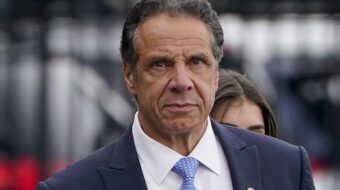It is a sign of the times that we are so focused on stopping George W. Bush’s rush to war in Iraq that most of us didn’t even know that seven astronauts were in space until the Shuttle Columbia’s tragic end. The media reports the space program on the back pages nowadays until disaster strikes. But every warmongering phrase of the Commander in Chief appears on page one.
The space age transformed the way we visualize the world. The images transmitted back from space make our planet appear fragile, a jade and turquoise gem on black velvet. We could easily smash it through recklessness or procrastination.
I was a high school senior in an isolated farming community in Washington State on Oct. 4, 1957, when news arrived that the Soviet Union had orbited Sputnik. My family rejoiced at the technological prowess of the world’s first socialist state.
They did it again in 1961, launching Yuri Gagarin, the first human being in space. A few months later came Gherman Titov. And then Valentina Tereshkova, the first woman in space. In 1981, Cuban Gen. Armando Tamayo Mendez became the first person of African descent in space, flying aboard the Soviet Soyuz.
These achievements began only a few years after the Soviets lost 20 million people, their nation half destroyed, defending their country from the Hitler invaders.
In 1974, the Soviet Embassy invited this reporter to travel to the Soviet Union on Aeroflot’s inaugural Washington to Moscow flight. In the delegation were U.S. astronauts Bruce McCandless, Paul Weitz and Dr. Joe Kerwin. Weitz and Kerwin had recently returned from 28 days aboard Skylab II. Skylab had been damaged during launch and the astronauts went “extra-vehicular” to break loose a jammed solar panel. They also deployed a big sheet of gold foil to protect the craft from the broiling sun. During a banquet in Leningrad, Kerwin told our hosts that he had looked out the Skylab window while flying 200 miles above the Soviet Union and admired its beauty and immensity. “We must work together to achieve lasting peace both on earth and in space,” he said.
For the Cold Warriors, Soviet space achievements were a “threat “ and they were in a desperate race to catch up. These elements then, and now, see space as the final battlefield. They are determined to deploy nuclear-powered Star Wars weapons in space. It is a key element of their strategy for U.S. global domination.
But there was always a counter-force, seeking to preserve space as a realm of peace and cooperation. There was even a treaty signed to preserve space for peace, now actively flouted by George W. Bush. The peace-in-space trend got its most dramatic boost when the Apollo spacecraft linked up with the Soviet Soyuz spacecraft, July 17, 1975. It was followed years later by visits of U.S. astronauts to the Soviet’s Mir (Peace) space station in the 1980s.
Today, the Soviet Union is no more. But the International Space Station is a symbol of peace and cooperation. Dependent on the space shuttles for crew transport, resupply and keeping it in orbit, the space station’s future has been placed in jeopardy by the Columbia disaster. Only three shuttles of the original fleet of five are left and all of them are more than 20 years old.
The Columbia disaster has stirred a debate on the value of space exploration with many asking how we can justify spending for NASA at a time of mass unemployment and poverty. Some argue that “Tang and Teflon” are the only breakthroughs produced by manned space flight. But Sen. Bill Nelson (D-Fla.), a former astronaut, cites a long list of technologies, including the CAT scan, that were spin-offs from the space program. The Apollo Moon project of the 1960s gave a huge impetus to development of the microchip essential for the on-board computer that guided the spacecraft to the moon and back. The size of a basketball, it had the power of one of those enormous mainframe computers the size of a basketball court. It can be argued that the personal computer and the Internet were byproducts of space exploration.
The Hubble Space Telescope is an unmanned satellite. But the focusing mechanism was damaged during launch and it had to be repaired by a Shuttle crew. The Hubble telescope, with the power to capture light 5 billion light years away, has fundamentally altered our understanding of the origin of the universe.
The New York Times carried a letter to the editor Feb. 3 by a reader mourning the death of the Columbia astronauts. “I hope that President Bush will do the right thing by slowing down his march to war and focusing instead on the healing that such a blow to national pride requires,” he wrote.
War will devour resources needed for education, health care, and jobs here on earth as well as funds needed for peaceful space exploration. We keep the Columbia astronauts’ dream of space travel alive, and the reachable goal of exploring Mars, in struggling to stop Bush’s runaway war machine.
Tim Wheeler is editor of the People’s Weekly World. He can be reached at greenerpastures21212@yahoo.com









